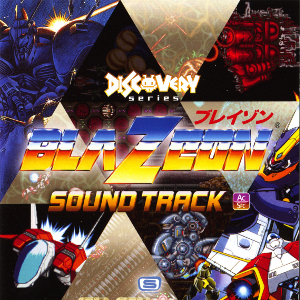Blazeon Soundtrack
 |
Album Title: Blazeon Soundtrack |
| Record Label: Sweep Record |
|
| Catalog No.: SRIN-1079 |
|
| Release Date: March 23, 2011 |
|
| Purchase: Buy at Sweep Record |
Overview
Atlus’ Blazeon was a traditional shooter released in 1992 for arcades and later ported to the Super Nintendo. It features music by Tsukasa Masuko, known for his work on the early Shin Megami Tensei titles. Its soundtrack has been released nearly two decades later as part of Sweep Record’s Game Music Discovery series dedicated to Atlus. It features a variety of soundscapes from both the arcade and console versions of the title.
Body
While the soundtrack release does feature both the original arcade sound and the ported Super Nintendo sound, I’ll mainly be focusing on the arcade version of the soundtrack. Both soundtracks are the same compositionally, but I feel the Super Nintendo version is a bit inferior as some of the allure of the arcade soundtrack is lost with the Super Nintendo synthesizer choices. Nevertheless, those who played the console version of the game may appreciate the choice to include both versions.
The album opens up with the demo/stage one theme, “Optimistic Departure.” It’s an upbeat and resolute theme that definitely draws inspiration from the Darius series. The beats are very nice and the overall atmosphere is convincingly achieved despite the synth limitations. The boss theme, “Intimidating Spaces,” also sounds inspired by the more percussion focused Darius boss themes. However, at the same time, there is definitely a melodic push. Sinister and hasty synthesizers really give this one a progressive rock sound and, in a way, reminds me of some of Masuko’s Shin Megami Tensei work.
The stage two theme is split into two different sections. The first, “Cosmic Ocean Blue,” is definitely a more atmospheric and somber composition that definitely gives off the feeling of a water environment. I really like the upbeat and motivating bass line as it helps give some drive to the more crystalline and calming synthesizer in the melody line. “Alpha,” the second half, is much more invigorating and upbeat.The motivating bass line returns while the melody becomes more heroic and spacey in sounds. I particularly enjoy the melody in this one, as the progressive keyboard work makes for a fantastic tone builder.
The stage theme theme, “Infinite World,” has a very chilling atmosphere. It features a very spacey soundscape and features both heroic and sinister flourishes due to the contrasting A and B sections. It’s one of the weaker stage themes when compared to the more melodic and energetically focused ones, but it does manage to make up for it in terms of atmosphere. The mid-boss theme, entitled “Unlimited Attack,” carries a very ominous atmosphere. This one is also reminiscent, in my opinion, of some of Masuko’s Shin Megami Tensei works. It’s definitely more percussion heavy than “Intimidating Spaces,” and the chaotic melody line only accentuates this feeling.
The first half of stage four, “Fighting Machine,” is definitely reminiscent of a Shin Megami Tensei theme, particularly “Ginza,” at least in the introduction. However, the melody is stellar and would fit in a variety of games. It does remind me a bit of F-ZERO at times and, for the most part, it’s an engaging ride full of energy. The second half, entitled “Emergency Avoidance,” definitely emanates that classic arcade sound. The rhythms are really interesting, especially with the upbeat bass line and the accompaniment working together to create a heroic touch. The melody line is extremely catchy and the keyboard work, while not as crazy as in some of the other themes, manages to capture that emergency sort of sound hinted at in the title.
The final stage theme, “Battle of Silence,” is both ominous and sinister. It focuses on suspenseful melody leads that are used sporadically in nature and a constant, tense beat that really helps build up a feeling of desolation with times of heroic tones. While it doesn’t develop much melodically, the atmosphere is definitely a winner, but it is one of the weaker stage themes on the album. Lastly, the ending theme, “Hop, Step, Jump!,” is reminiscent o Sonic the Hedgehog, particularly in the A section, while the B section gives off a soundscape more reminiscent of F-ZERO. It’s upbeat, playful, and definitely gives off a sense of relief. The melody and harmonies are quite good and, while the beat doesn’t do anything too interesting, it matches well with the overall pace of the theme. Not a bad way to end the game.
Summary
While some of Tsukasa Masuko’s later works have been hit or miss, depending on who you ask, I find his retro works to be a much more inspired affair. The Blazeon Soundtrack manages to capture the essence of those classic arcade shmup games. He’s able to put his stylistic spin on many of the tracks, particularly with the use of the hasty keyboard sections, but he’s also able to create some differentiated atmospheres as well. The soundtrack release comes with both the arcade and Super Nintendo sound sources, so it’s a nice way to compare the two versions of the theme, but most will ultimately find the arcade sound source to be superior. This is definitely another successful release in the Game Music Discovery series.
Do you agree with the review and score? Let us know in the comments below!
4
Posted on August 1, 2012 by Don Kotowski. Last modified on January 23, 2016.














